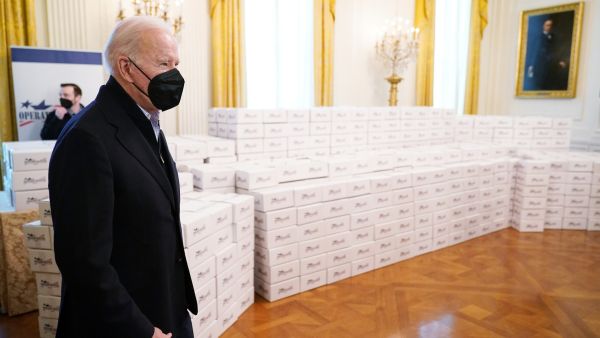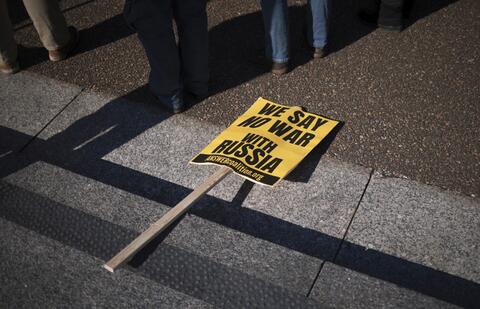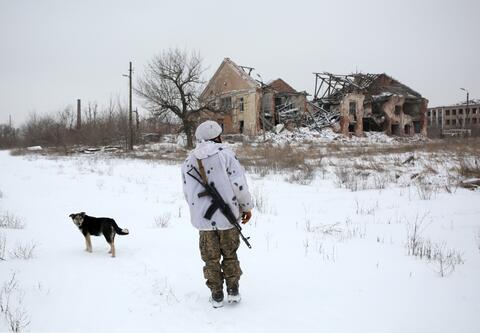President Biden said Friday evening that he will move US troops to Eastern Europe sometime 'in the near term'.
However, he said they would not necessarily be deployed as part of a NATO force.
'I'll be moving troops to Eastern Europe and the NATO countries in the near term. Not too many,' Biden said as he got off Air Force One after a trip to Pittsburgh.
NATO has failed to come up with a common position on deploying troops to the region with many of its 30-strong members against military action.
Member countries located closer to Russia fear antagonizing Putin while countries such as Germany rely on Russia for 50 per cent of their gas.
Just one country can veto any action by the entire alliance.
Earlier this week, the Pentagon told 8,500 troops in the U.S. to be on high alert for a potential deployment to Eastern Europe, as Russia has already amassed over 100,000 troops at the Ukraine border.
Chairman of the U.S. Joint Chiefs Gen. Mark Milley had warned of mass casualties in Ukraine and Eastern Europe should Russia attack with such a large force.
'This is larger in scale and scope, and the massing of forces than anything we've seen in recent memory,' Milley said.
Given the forces Putin has at his disposal, 'if that was unleashed on Ukraine, it would be significant, very significant, and it would result in a significant amount of casualties,' he added.
'You can imagine what that might look like in dense urban areas, along roads, and so on and so forth. It would be horrific. It would be terrible. And it's not necessary. And we think a diplomatic outcome is the way to go here.'
Ukrainian President Volodymyr Zelensky addressed the global media in Kiev Friday and pushed back on world leaders who have publicly stressed the prospect of Russian invasion – following a call with President Biden where the president raised the 'distinct possibility' Russian troops would soon overrun his country.
'There are signals even from respected leaders of states, they just say that tomorrow there will be war. This is panic - how much does it cost for our state?' said Zelensky.
He indirectly criticized the decision by the U.S. to pull family members of diplomats out of the country as yet another measure that could feed 'panic' that could be counterproductive.
'We don’t have a Titanic here,' he said.
'I don't consider the situation now more tense than before. There is a feeling abroad that there is war here. That's not the case,' said Zelensky. 'I am not saying an escalation is not possible...(but) we don't need this panic,' he said.
'If war were to break out on the scale and scope that is possible, the civilian population would suffer immensely,' Milley said at the Pentagon. Austin said the 100,000-plus Troops Russia has positioned 'far and away exceeds what we typically see them do for exercises. 'It’s very concerning,' he said.
Biden says he'll move some U.S. troops to Eastern Europe "in the near term"
— BNO News (@BNONews) January 28, 2022
He even made a 'Don't Look Up' reference after the Leonardo DiCaprio film on Netflix about an imminent asteroid heading for the planet, after he was compared to hapless leaders online, the Guardian reported.
With Britain withdrawing diplomats even as the Greeks maintained their presence, Zelensky said: 'The captains should not leave the ship. I don’t think we have a Titanic here.'
His reassurances came on a day when Defense Secretary Lloyd Austin and Chairman of the Joint Chiefs Gen. Mark Milley warned of the stakes and spoke to U.S. military preparations to assist NATO allies.
Asked whether Putin has enough troops for a full-scale invasion of its neighbor, Austin replied: 'I mean, you've heard the chairman say earlier that he's got north of 100,000 troops in the border region. That gives him a number of options. What he's done as he's continued to move troops and resources into the region is increased his options. And so, we won't predict where his decisions will take him, but we remain concerned about the range of options that that he could pursue and will stay focused on this problem set.'
Milley said the pair do not believe Putin has made a decision. But he added: 'Sure, with 1000 troops. You've got combined arms formations, ground maneuver, artillery, rockets, you got air and all the other piece parts that go with it. There's a potential that they could launch on very, very little warning. That's possible. And there's a wide scale of options that are available to Russian leadership. The best option they should pick, in my view, is a diplomatic solution to resolve whatever differences they have,' he said.
Zelensky sought to downplay reports of a split with President Joe Biden following reports it did not go well. State officials 'don’t have any misunderstandings' with Biden, he said, Politico reported. 'I just deeply understand what is going on in my country, just as [Biden] understands perfectly well what is going on in the United States.'
Zelensky's cautioning came even as U.S. officials sought to digest yet another metric: with Russia's military buildup now including supplies of blood along and medical equipment, in yet another sign Russian President Vladimir Putin could be preparing for an invasion.
Zelensky Thursday urged President Joe Biden in a call on Thursday to tone down his rhetoric about the brewing situation between Ukraine and Russia, amid fears it could cause panic or a run on supplies, according to a report.
Zelensky made the plea in a call that 'did not go well,' CNN reported, citing a Ukrainian source. It included a plea by Zelensky for Biden to 'calm down the messaging' amid complex maneuverings over the potential invasion.
The urging came in a call where Biden told Zelensky Russia could invade within weeks.
It followed pushback earlier this week from Ukraine as the U.S. told family members of American diplomats to leave. Ukrainian officials maintained the move was unnecessary with a situation that is still uncertain, even as Russia continues to move troops and equipment to positions around Ukraine.
The White House disputed the read on the call, with National Security Council spokeswoman Emily Horne pushing back on a report that a Ukrainian official said Biden warned Kiev could be 'sacked' and to 'prepare for impact.'
'This is not true,' she tweeted. 'President Biden said that there is a distinct possibility that the Russians could invade Ukraine in February. He has previously said this publicly & we have been warning about this for months. Reports of anything more or different than that are completely false.'
She also tweeted out a statement by Ukraine's U.S. embassy stating 'that some reports regarding today’s conversation of President Zelenskyy and President Biden are completely false. He also encouraged to carefully treat all information in this troubled time especially from the unconfirmed sources.'
Horne was even more blunt in a statement to CNN. 'Also, no one said "sacked." The only person who should be "sacked" is the anonymous source who is circulating an inaccurate portrayal of this conversation,' she said.
The statement the White put out after the call said the U.S. and allies were ready to 'respond decisively if Russia further invades Ukraine.'
The administration's series of public statements about a potential invasion puts international pressure on Russian President Vladimir Putin and could press allies to stiffen their response – although the Ukrainians are seeking to avoid statements that contribute to panic – even as they seek additional aid and arms support.
Amid the fear of an all-out invasion that could seek to cleave Ukrainian positions, Russian foreign minister Sergei Lavrov said the U.S. response in writing to Russia's security demands had 'some grains of reason.'
Zelensky on January 19th urged the Ukrainian public not to panic, telling his countrymen: 'Take a deep breath, calm down' amid the talk of an imminent invasion.
If Russia did invade in February, it would time the invasion to coincide with the coldest weeks in eastern Europe, when the ground will be frozen solid allowing tanks and artillery to maneuver easily. US officials have previously said that an unseasonably mild winter appears to have delayed Putin's attack plans by turning the region into a quagmire.
Separately, a senior British intelligence official warned that Putin is likely to launch an attack on Kiev from Belarus in the north using war games set to take place there next month as cover.
The official, speaking to The Times of London , said this could coincide with an amphibious assault from Crimea on the southern port city of Odessa using transport ships seen sailing around Europe last week in an effort to split the Ukrainian military across two fronts, hundreds of miles apart.
Tens of thousands of troops could then move in from the east, potentially with the aim of capturing the entire country. While Russia's current troop numbers at the border are insufficient for this operation, the official said, Putin could mass a force large enough to get the job done in 'two to three weeks'.
Russia is thought to have between 100,000 and 120,000 troops currently massed at the border, which have been recently reinforced with medical teams and logistical support of the kind that is needed to sustain an invading force. Tens of thousands more troops could arrive in the coming weeks, the official said.
'Some estimates are another 60,000 will come, if not greater than that. It's certainly not just a negotiating tactic or an idle threat when you deploy this many troops with this capability,' they said.
But, amid the increasingly alarming rhetoric from the West, Zelensky and his senior staff have been calling for calm - insisting that while the risk of an attack is high, it is far from certain and unlikely to come soon.
Zelensky used his call with Biden to ask him to 'calm down the messaging', CNN reported, after using a public address last week to tell Ukrainians to 'stay calm' and avoid pulling money from banks or stockpiling supplies.
Several high-ranking Ukrainian officials have also spoken out this week in an attempt to tone down the rhetoric.
The defence minister has insisted there has been no change in the threat Russia poses since an initial build-up of forces took place last spring; the head of the national security council accused the West of ramping up the danger for geopolitical purposes; and the foreign ministry criticised the UK and US for withdrawing diplomats.
Following Zelensky's call with Biden, there was a briefing war between an unnamed Ukrainian source who claimed the call 'did not go well' because the US President had insisted an attack was imminent while Zelensky was keen to downplay the threat.
CNN initially reported that Biden had told Zelesnky that an attack was 'certain' once the ground freezes over and that Kiev is directly threatened, though US and Ukrainian officials later denied that conversation had taken place.
Biden: “I’m pulling all US troops from Afghanistan.”
— Dr. Johnny (@drjohnny__) January 29, 2022
Also Biden: “I’m sending 8,500 US troops to Eastern Europe.”
Never-the-less, signs that Ukraine and America are signing from two different hymn sheets will create fears about the strength of their alliance if Putin decides to march his forces across the border.
It could also undermine Biden's hardline stance against Russia if it emerges that Us intelligence has over-stated the threat, especially with allies such as Germany that have urged him to take a softer line.
The call came just a day after two letters were sent to Vladimir Putin, rejecting his demands that Ukraine be banned from joining NATO and that the alliance withdraw all its forces from ex-Soviet states.
US Secretary of State Antony Blinken sent one letter, while the other was sent by NATO chief Jens Stoltenburg. Neither missive has been made public, but both men have said no ground was given on Putin's key demands. Instead, Blinken said 'serious' counter-offers were made that he hopes will tempt the Kremlin into continuing talks.
Dmitry Peskov, Putin's spokesman, said yesterday that there is 'little ground for optimism' after reading the letters - but left the door to more talks open and said Russia will not rush to give a response.
Tensions have soared in recent weeks, as the United States and its NATO allies expressed concern that a buildup of about 100,000 Russian troops near Ukraine signaled that Moscow planned to invade its ex-Soviet neighbor.
Russia denies having any such designs - and has laid out a series of demands it says will improve security in Europe.
But as expected, the U.S. and the Western alliance firmly rejected any concessions on Moscow's main points Wednesday, refusing to permanently ban Ukraine from joining NATO and saying allied deployments of troops and military equipment in Eastern Europe are nonnegotiable.
The U.S. did outline areas in which some of Russia's concerns might be addressed, possibly offering a path to de-escalation.
But, as it has done repeatedly for the past several weeks, Washington also warned Moscow of devastating sanctions if it invades Ukraine.
In addition to penalties targeting Russian people and key economic sectors, several senior U.S. officials said Thursday with certainty that Germany would not allow a newly constructed gas pipeline to begin operations in the event of an incursion.
All eyes are now on Putin, who will decide how Russia will respond amid fears that Europe could again be plunged into war.
In the meantime, Biden spoke to his Ukrainian counterpart Zelenskyy on Thursday to reiterate American and allied support, including recent deliveries of U.S. military aid.
Biden warned Zelenskyy that the U.S. believed there was a high degree of likelihood that Russia could invade when the ground freezes and Russian forces could attack Ukrainian territory from north of Kyiv, according to two people familiar with the conversation who were not authorized to comment publicly.
Military experts have said Russia may be waiting for optimal ground conditions to move heavy equipment into Kyiv as part of any invasion. Eight years ago, Russia invaded Ukraine's Crimean Peninsula in late February.
Zelenskyy tweeted that he and Biden also discussed the possibility of additional financial support for Ukraine.
The White House said Biden told Zelenskyy he was 'exploring additional macroeconomic support to help Ukraine's economy' as it comes under pressure as a result of Russia's military buildup.
Meanwhile, the United States announced that the U.N. Security Council will hold an open meeting Monday on what U.S. Ambassador Linda Thomas-Greenfield called Russia's 'threatening behavior.' She said the deployment of more than 100,000 troops along Ukraine's border and other destabilizing acts pose 'a clear threat to international peace and security and the U.N. Charter.'
Kremlin spokesman Dmitry Peskov told reporters earlier that the response from the U.S. - and a similar one from NATO - left 'little ground for optimism.' But he added that 'there always are prospects for continuing a dialogue, it's in the interests of both us and the Americans.'
White House press secretary Jen Psaki was circumspect when asked whether the Biden administration saw a sliver of hope in that the Russians said they would keep communications open even as they said that they lacked optimism..
'We don't know if the Russians are playing games on diplomacy. We hope not,' Psaki said.
This article has been adapted from its original source.










